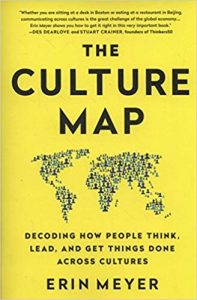More work-related reading for this post with The Culture Map by Erin Meyer, it has the lengthy subtitle “Decoding how people think, lead, and get things done across cultures”.

Meyer’s thesis is that there are national cultures which can be described by a countries location on a set of eight axes, and managing fruitful international collaborations requires recognition of this fact and an appreciation of where the team members lie on this scale.
The book is divided into eight chapters, each concerning one of the axes. Typically a chapter will start with what one might term an anecdote or case study which introduces an incident which illustrates the wider point of the chapter. These are all very personal and individual, there are names of people and companies, and specific meetings and scenarios. This is followed by a summary table which lists out where different countries fall on this particular axis and then goes on to suggest some strategies to address potential issues in multicultural teams.
The eight axes are:
- Communicating – is communication high-context (i.e. implicit) or low-context;
- Evaluating – is negative feedback provided directly or indirectly;
- Persuading – principles-first or applications-first? To convince someone do you describe a concrete instance (application) or recommendation or start with a theoretical model (principles)?
- Leading – hierarchical or egalitarian;
- Deciding – are decisions made consensually or top-down?
- Trusting – is trust based on tasks (i.e. work successfully completed) or relationships (sharing meals and drinks);
- Disagreeing – is disagreement confrontational or non-confrontational;
- Scheduling – is scheduling linear-time (i.e. on time) or flexible-time?
In most cases the themes are considered in isolation but in a couple of cases there are interactions. For example, between communication styles (high and low context) and negative feedback styles (direct and indirect). The US, and to some degree UK and Canada, are unusual in that they favour low-context, explicit communication but indirect negative feedback. The second case is in the disagreeing style (confrontational or non-confrontational) where a ninth axes is slipped in: emotional expressiveness.
As someone with a background in the physical sciences this type of of book can be a bit challenging. Physical scientists expect theoretical models, such as the one presented here, to represent an underlying physical truth. The model is therefore, crudely, right or wrong. Outside the physical sciences a model can be something else: a framework for exploration and discussion. That’s to say the important thing is not the “correctness” of a model but the opportunity it presents in framing discussions. I suspect this makes us principles-first on the persuading axis.
In this case the physical scientist in my wants to argue about whether there really are 8 axes or should it be fewer (or more) and how well-established is the evidence for each of these axes. For some axes Meyer cites academic work in support. She also provides some rationalisation for where countries fall on an axes on the basis of history or prevalent religion.
The book presents itself as a manual for working between cultures but I wondered from the start whether it was more generally applicable. Individual styles vary within a national culture, if I look at my approach to timekeeping then I fall on the positively Germanic end of the scale, whilst other English people I work with have a much more Italian view of timekeeping. Arguably software developers as a group are on the “low context” end of the communication scale, computers are pretty much the definition of low context communicators – everything is absolutely explicit.
Meyer does touch on this idea briefly at the beginning of the book, talking about how the national scores on a scale represent the average across the distribution of individuals’ scores for a nation but doesn’t really pick it up as an idea.
Some themes arise in these solutions, the first of which is that recognising difference is half the battle. The second is about being explicit about how you will handle areas of potential misunderstanding. Finally, there is a warning about not trying too much to ape characteristics that are not your own. For example, if you come from a culture where criticism is typically indirect, don’t go all out to be direct in your criticism because it really is possible to go too far and you won’t be a good judge of what “too far” is.
I’ve noted when reading books on marketing that the style they use has a distinct marketing air, and I wonder whether the same is true for this book. Are the anecdotes about dinner to appeal to our relationship-trust side, and the summary tables our task-based trust side?
This is really a book which I wish I’d read long ago, in part because I’ve worked in international teams as an academic and commercially in both small and large companies. But also because I see in this book as a guide to working with people more generally, even those in the same culture.

